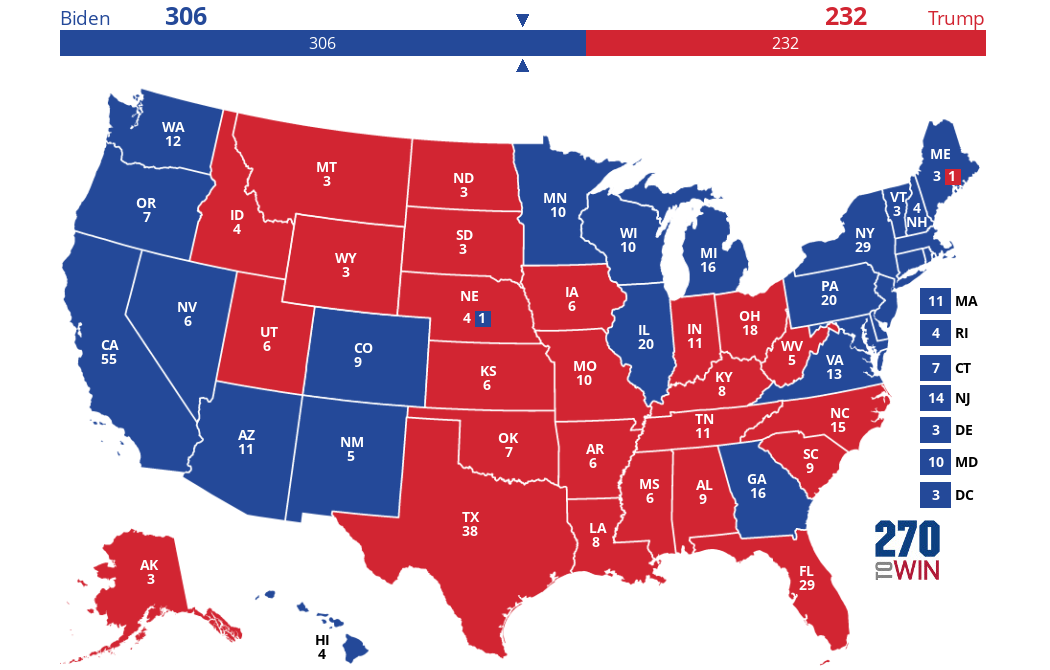Where Things Stand: 2020 Election Results Maps
By 270toWin Staff
November 28, 2020
Interactive maps for the November 3, 2020 general election. A few races remain uncalled as of this writing; the maps will update as elections are decided.
President
States continue to certify the results. See the current certification map and calendar here. The electors meet to vote in their respective states December 14.
Five states Donald Trump won in 2016 were won by Joe Biden: Arizona (11), Georgia (16), Michigan (16), Pennsylvania (20), Wisconsin (10). In addition, Biden won the electoral vote associated with Nebraska's 2nd district. Before accounting for faithless electors, the result is a mirror opposite of Trump's 306-232 win in 2016.
Senate
Democrats gained two seats (Arizona and Colorado) while Republicans flipped Alabama. None of these was a large surprise. The GOP was able to sweep the other seats seen as most competitive: Iowa, Maine, Montana and North Carolina. Control of the Senate in 2021 will come down to two runoff elections in Georgia on January 5. Republicans maintain control by winning either of these runoffs.
The 117th Congress is expected to be seated on January 3. There will be seven new Senators sworn in that day: Tommy Tuberville (R, AL); Mark Kelly (D, AZ); John Hickenlooper (D, CO); Roger Marshall (R, KS); Ben Ray Lujan (D, NM); Bill Hagerty (R, TN); Cynthia Lummis (R, WY).
House
Democrats will retain control but with a notably smaller majority. Heading into the election, the party held a 233-201 advantage, with one Libertarian. As of this writing, that number is 222-209, with four seats uncalled. NY-1 seems almost certain to stay in GOP hands, which will make it 222-210. The other three races are incredibly tight. See the latest results below the map.
Aside from two seats gained through court-ordered redistricting in North Carolina, the only Democratic flip was in GA-7. Republicans have won back at least 10 seats they lost in 2018. With these gains, Republicans will have the majority of House delegations in 26 or 27 states, while Democrats will have 20. Currently, the GOP edge is 26-23.
The 117th Congress is scheduled to be seated on January 3. Speaker Pelosi's majority will get even more narrow after that, at least temporarily. At least one member, Cedric Richmond (LA-2) has been tapped to join the Biden Administration; he is expected to resign before January 20.
CA-25: A rematch of the district's special election held in May, after the resignation of former Rep. Katie Hill. Republican Mike Garcia flipped the seat.
IA-2: Incumbent Democrat David Loebsack did not seek reelection.
NY-22: A rematch of the 2018 election; Democrat Anthony Brindisi defeated incumbent Republican Claudia Tenney.
Governor
Only one of the 11 seats up for election this year was expected to be highly competitive. In the end, Greg Gianforte won that Montana race rather easily, flipping the seat for the GOP. Gianforte will be one of two new governors; Spencer Cox (R, UT) succeeds the retiring fellow Republican Gary Herbert. The tightest election ended up being in North Carolina, where incumbent Democrat Roy Cooper won by 4.5% over Lt. Gov. Dan Forest.
2021 will bring gubernatorial elections in New Jersey and Virginia.





